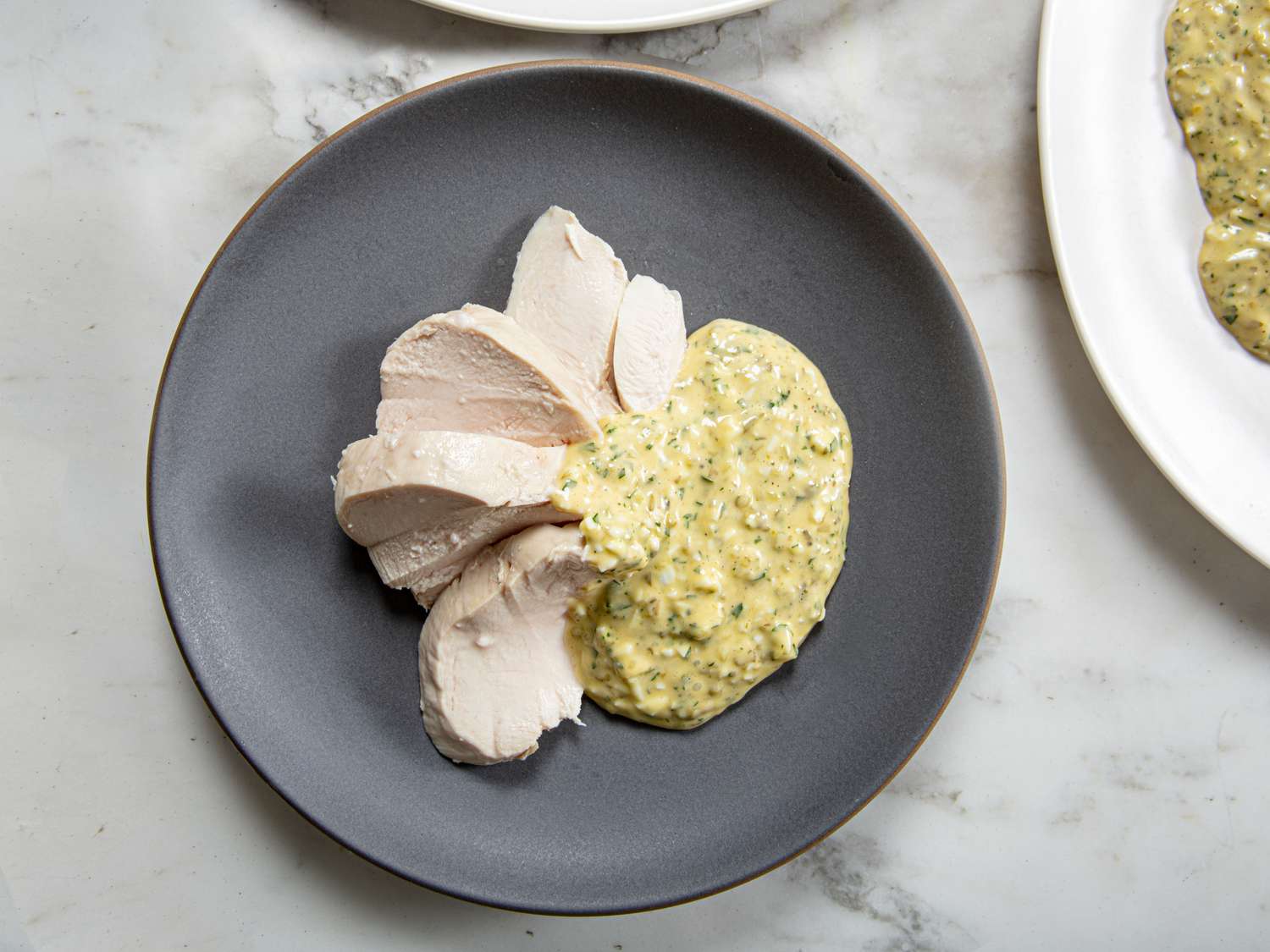

Why It Works
- Starting in cold rather than simmering water gets the chicken cooking from the outset and helps to gently bring it up to temperature.
- Using a thermometer to track the water temperature and the chicken’s internal temperature removes the guesswork that is common to many other poached chicken recipes.
- Holding the poaching water closer to the chicken’s ideal internal temperature ensures it is perfectly cooked, tender, and juicy, not tight and dry as it is when simmered.
Baked, roasted, braised, and fried chicken are inarguably delicious. Poaching, by comparison, can seem bland. And yet, when done well, poached chicken is unsurpassed in its tender texture, juiciness, and pristine flavor. While you can—and should—poach any part of the bird, we find that the gentle, wet cooking method works particularly well for breasts, so that’s what this recipe focuses on. It’s a method that is highly regarded in some cuisines (Chinese, just to name one), and deserves far more respect and attention than it tends to get here in the United States.
The key to great poached chicken, though, is to cook it such that the meat remains absolutely tender and juicy throughout. Too often, chicken poaching recipes lead to the opposite result, one in which the chicken comes out overcooked, dry, and stringy despite the wet cooking medium. The question, then, is how to devise a chicken poaching method that is repeatable, foolproof, and free of the guesswork and imprecision that troubles so many of the common approaches?
Poaching Precision: Why Many Poaching Methods Don’t Work Well
Most recipes for poached chicken have you add the breasts to simmering or boiling liquid, often water with some aromatics added. One of the most common methods tells you to remove the pot from the heat as soon as the chicken goes into it, then let it stand for 30 or 40 minutes until the chicken is cooked through. I don’t love that lack of precision—different-sized chicken breasts will cook in different times, and the varying ratio of water to chicken will change the rate at which the water cools, throwing off cooking times even more. You can too easily end up with chicken that is overcooked or undercooked, and you won’t even know it until you cut into the breast.
Another common method has you hold the chicken at a simmer until it is fully cooked through. This eliminates the risk of serving undercooked chicken, but it increases the risk of overcooking. That’s because a simmer is quite a bit hotter—just under water’s boiling point of 212°F (100°C)—than the ideal temperature of chicken breast meat, which is closer to about 155°F (68°C).
This made me wonder whether there wasn’t a better way to poach chicken, one that cooks it more gently from start to finish, ensuring doneness without over-doneness. I started wondering whether I couldn’t improve upon the chicken approach using a technique I’ve seen and used before with seafood: cold-start poaching. After all, that’s more or less what chicken breast cooked sous vide is, except that with sous vide, the chicken is in a plastic bag.
Cold-Start vs. Conventional Poaching
To test it out, I cooked two bone-in, skin-on chicken breast halves separately in two pots of water that I’d seasoned with salt and flavored with scallion and ginger. I dropped one of them into boiling water, then maintained the simmer until the thickest part of the chicken had reached 150°F (65°C) on an instant-read thermometer. I added the other to the water while it was still cold, then brought the water up to about 150°F and cooked it until the inside of the chicken had reached the same final temperature; I adjusted the heat to maintain the water’s temperature, but wasn’t too strict about it—it sometimes hovered up around 160°F (61°C), or even a little higher.
Straight from the water, the differences were visible. The chicken cooked in the simmering water had skin that retracted more, while the gently cooked cold-start chicken retained a much more even covering of skin. I could also feel by pressing on the flesh that the simmered chicken was tighter and firmer to the touch than the cold-start poached chicken.
Once sliced, the exposed meat revealed similar results, with the lower-temp sample much tenderer and juicier than the simmered one, though the photos here don’t do a good job of conveying that visually. In person, there was no question about which was better.
The downside of the lower-temp method, of course, is that it takes longer due to the lower cooking temperature. My chicken breast halves weighed three-quarters of a pound each, and at that weight, the simmered one cooked in 30 minutes (including the time it took to bring the water to a boil), while the low-temperature one was just a little shy of one hour when it was ready—not a terribly long time if you’re prepping other things for dinner while it gradually cooks, but not ideal if you’re in a rush.
It’s important to note, though, that the times can be quite variable here, dependent on both the average temperature at which you’re able to hold your liquid and also the mass and thickness of your chicken breasts as well as whether they are bone-in or not. I’ve since had chicken breasts poach in about 35 minutes using the cold-start method simply because they were slightly smaller.
A Middle Ground for Quicker Results
You can split the difference, raising the poaching temperature to about 170°F (77°C), which is still lower than boiling/simmering water, but not quite as low as 150°F. That shaves some valuable minutes off, while still producing a tenderer piece of meat than simmering does.
I recommend you give it a try. After all, poached chicken not only yields delicious meat that’s a blank canvas for so many recipes, but also a flavorful broth that can be sipped or saved for future recipes.




